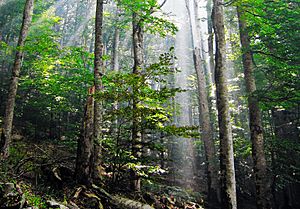Old-growth forest facts for kids
An old-growth forest is a very old forest that has grown for a long time without much disturbance from humans. You might also hear it called a primary forest, virgin forest, or primeval forest. These forests are like ancient natural museums, full of unique plants and animals.
Old-growth forests have special features that make them important for nature. They often have many different kinds of trees, some very tall and some shorter. These trees create a multi-layered roof, called a canopy, which can block sunlight from reaching the ground. This creates unique conditions for plants and animals living below.
These forests also have lots of large, fallen logs and dead trees on the forest floor. These logs are not just waste; they are important habitats for many creatures and help new plants grow. They also add nutrients back into the soil as they decay.
Contents
Why are Old-Growth Forests Important?
Old-growth forests are incredibly important for the environment. They are home to a huge variety of plants, animals, and fungi, which is called biodiversity. The different tree sizes, the fallen logs, and the varied canopy all create many different places for wildlife to live.
For example, some birds nest only in very tall, old trees. Certain insects and fungi depend on decaying wood. These forests are often considered a "climax community," meaning they have reached a stable state where the types of plants and animals living there are well-established and balanced.
Where are These Forests Found?
Sadly, old-growth forests are quite rare today. In Europe, less than 7% of forests are old-growth. This is mainly because of industrial logging that happened in the 20th century. In the United States, it's estimated that only about 10% of the original old-growth forests are left. In Asia, some old-growth forests have been lost due to conflicts in different regions.
Protecting these remaining ancient forests is very important. They are vital for biodiversity, climate regulation, and for understanding natural ecosystems.
Images for kids
-
Cool temperate rainforest in Tasmania, Australia
-
Coast redwoods in old-growth forest in Muir Woods National Monument, Marin County, California
-
Antarctic Beech old-growth in Lamington National Park, Queensland, Australia
-
The northern spotted owl primarily inhabits old-growth forests in the northern part of its range (Canada to southern Oregon) and landscapes with a mix of old and younger forest types in the southern part of its range (the Klamath region and California).
-
Virgin forest about 2500 m above sea level in Shennongjia Forestry District, Hubei, China
-
Downed wood replenishes topsoil as it decays.
-
Fungus Climacocystis borealis on a tree stump in the Białowieża Forest, one of the last largely intact primeval forests in Central Europe
-
Redwood tree in northern California redwood forest: According to the National Park Service, "96 percent of the original old-growth coast redwoods have been logged."
-
Avatar Grove near Port Renfrew, British Columbia: Giant Douglas firs (left) and red cedars (right) fill the grove.
-
Eucalyptus regnans forest in Tasmania, Australia
-
Old growth red cedar stump near Port Renfrew, British Columbia
-
Old-growth forest in the Opal Creek Wilderness, a wilderness area located in the Willamette National Forest in the U.S. state of Oregon, on the border of the Mount Hood National Forest. It has the largest uncut watershed in Oregon.
See also
 In Spanish: Bosque primario para niños
In Spanish: Bosque primario para niños













